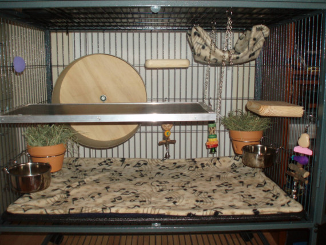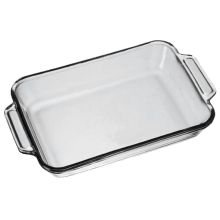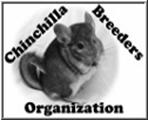
A cage equiped with a fleece liner
Once the liners have been secured in the bottom of the cage, the litter box can be added. The litter box should contain some form of bedding such as aspen or pine shavings or recycled paper bedding. Never use cat litter in a chinchilla’s litter box. Chinchillas have been known to eat cat litter and it is hazardous to their health. To help the chinchilla know what is expected of it, a handful or two of soiled bedding should be placed in the litter box along with the clean bedding. Most chinchillas have a favorite spot, usually a corner, for urinating. Place the litter box in that spot. If more than one spot has been used as a toilet, block the other areas with items such as the chinchilla’s house, food bowl or toys. The chinchilla should start using the litter box within a few days.

A glass baking dish
Fleece liners have a few advantages over the use of other types of cage bedding. One of these advantages is that chinchillas cannot throw or kick the bedding out of the cage. Both wood shavings and recycled products can end up all over the floor surrounding the cage when the chinchilla is active requiring a minimum of daily sweeping to keep the area clean. Fleece liners are also a great option for people who are allergic to other bedding materials or those who just do not like the smell of wood shavings. In the long run, fleece liners are the cheapest form of bedding available for chinchillas.
Although there are clear advantages to using fleece cage liners, disadvantages do exist. Fleece liners are by far the most expensive option, initially. Additionally, if the chinchilla has accidents or a litter box is not used, the liners will need to be changed at least every other day or the urine on them will begin to smell. Even though the liners can be washed in a washing machine, it is not recommended to wash them with clothing. Instead, they need to be washed in a separate load, by themselves.
Since chinchillas chew on everything and anything, a word of caution is necessary. Although fleece is considered safe for use in chinchilla cages, if the chinchilla chews on the fleece, it will need to be removed from the cage and another form of bedding should be used. If allowed to continue chewing on the fleece, a chinchilla can ingest some causing a deadly blockage of the chinchilla’s digestive system.



 Site Last Updated on December 31, 1969 05:00 pm
Site Last Updated on December 31, 1969 05:00 pm